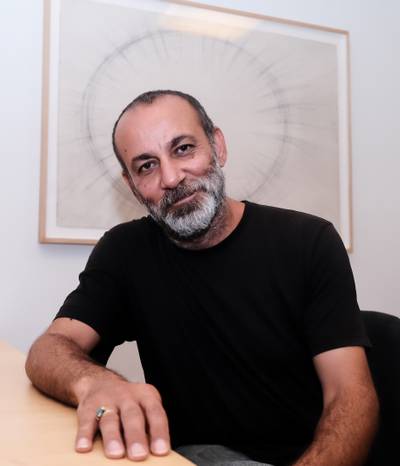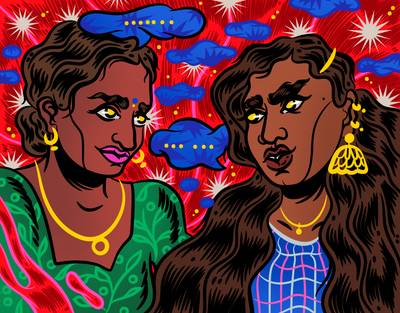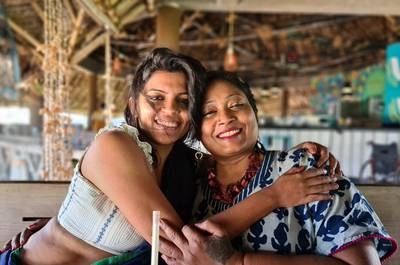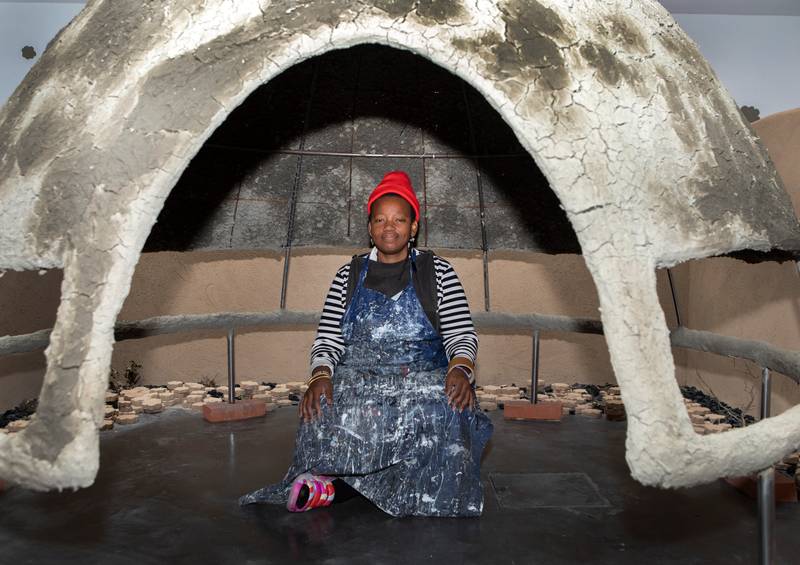

Dineo Seshee Raisibe Bopape, Image: courtesy of Finnish National Gallery, Petri Virtanen
Lotta Petronella is a filmmaker and artist based on an island in Finland. She is co- founder of CAA Contemporary Art Archipelago and has worked with and on islands for nearly two decades. Her latest work Materia Medica of Islands was part of Helsinki Biennial in 2023. In addition to her filmmaking and art practice, Petronella is a devoted medicine and flower essence maker and tarot scholar. She also writes poems, makes soundscapes.
The first time we met was at the Helsinki Biennial 2023, where we were both showing new work. Dineo’s I Re-member mama stands like a doorway in the harbour where the ferry to Vallisaari leaves. A portal and a tomb between the mainland and the island, between this world and the other world. It became an important work for me as I travelled to and from the island over the summer with the Laments Choir, performing rituals and songs of mourning. I felt that the work witnessed and protected us. Sitting there a little hidden, observing, and soaking in the night, the sun, the rain, and the saltless sea. Holding the space, the songs of the earth, where primordial and future meet, reminding us of the connection between mud, matter and mother.


Helsinki Biennial 2023, Re-member mama, Dineo Seshee Bopape, Image courtesy of HAM, photo: Sonja Hyytiäinen
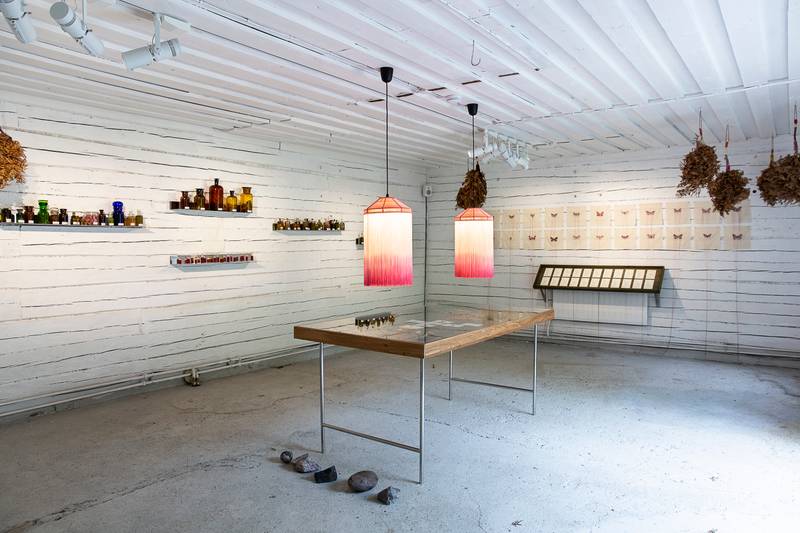

Helsinki Biennial 2023, Materia Medica of Islands, Lotta Petronella with Sami Tallberg and Lau Nau, Image courtesy of HAM, photo: Sonja Hyytiäinen
LOTTA: I would like to read you a poem by Adrienne Rich. I think this text resonates with your work, Re-member mama that you did for the Helsinki Biennial.
The words for mother and mud (earth, slime, matter of which the planet is composed, the
dust or clay of which ‘man’ is built) are extremely close in many languages: mutter,
madre, mater, materia, moeder, modder.1
I am also thinking of this work of yours as a portal.
DINEO: I kept seeing and photographing portals this morning during a walk. The trees had all been curved, and they looked like gateways. Matter came up as you were reading. And this relation between the words mother and matter and material. The matter of the earth, the muddiness, and also matter as an issue, story, or drama. How do we deal with the matter of our lives? Also, the different seasons and the matter of transitioning into the winter on that side and spring on this side, but also being in-between. Matter as the place where we are collectively together with everything - all the matter in the world, all these wars, concepts and teachings, and difficult meetings. I am also thinking about Audre Lorde, and her phrase of “Looking after myself is not self-indulgence, it’s an act of political warfare”.
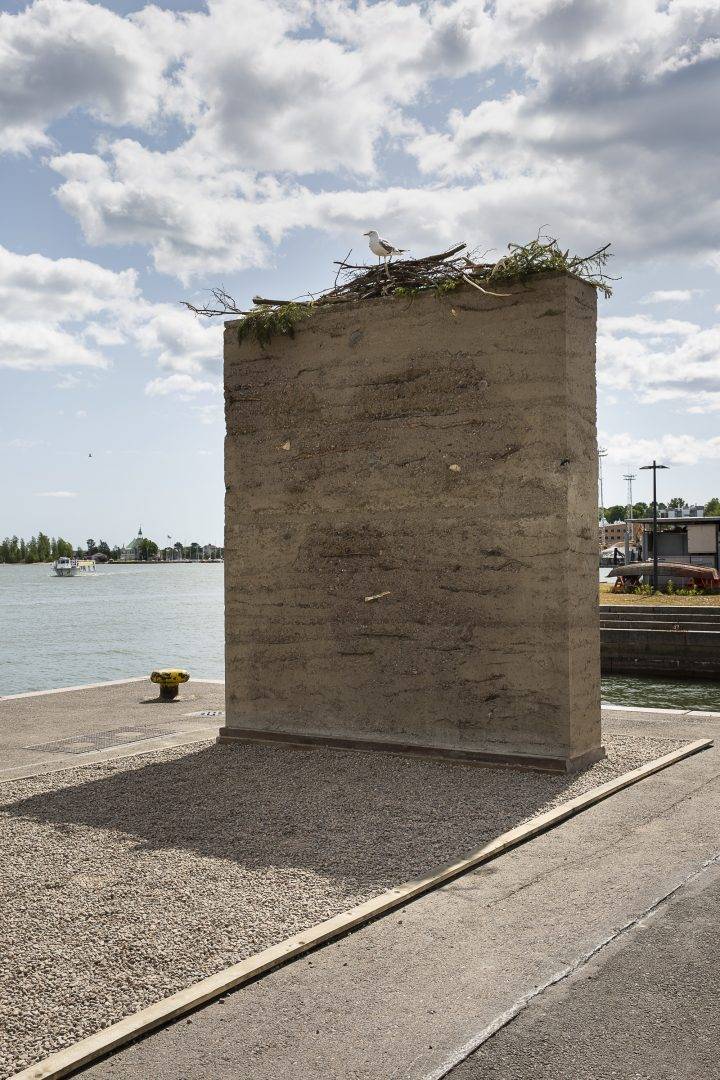

Helsinki Biennial 2023, Re-member mama, Dineo Seshee Bopape, Image: courtesy of HAM, Sonja Hyytiäinen
I feel that the earth (soil) in your work is also about skin. You are calling back the members, the ancestors, the membranes, the bodies, and the bones. So there’s something about the knowledge that we attain through our skin in connection to the porousness of the soil. Or acknowledging the earth as the skin that we are walking on. Walking as a receptive, radical and intimate act.
A friend of mine sent me an image today that he had been working on reflecting on what’s happening in Gaza. The image was so horrific. This is what I actually engaged with coming back from the walk. It made me think, should one then represent the image, as it is amplifying the horror, or is there another kind of witnessing that is needed in order to know and understand more about it? Maybe we also need to be somewhat horrified out of our comfortable state, but then, do we also need to be traumatised altogether?
We are watching the horrors live on our screens. How to witness without becoming desensitised so we don’t stop seeing those images anymore because they become somehow dangerously ‘normal’.
Yes, it easily becomes oversaturated. I found myself so upset with the messenger, with my friend, who was showing me this interpretation of what was happening to these children being filmed. This sent me to look at images of wars and how other artists have represented the war, famously Picasso. So I spent time this morning looking at the Guernica. I wanted to see what was depicted there, what was the horror shown there, and how else it could be spoken about. I am wondering whether I was too desensitised from the Guernica and could not see it anymore. I saw a Picasso drawing—not a woman screaming, not a horse tramping on somebody—I just saw a very expensive painting.
Another of the images I ended up looking at today was a video going around of a family in Gaza looking for their children because the street had been bombed. The kids were playing there, behind the olive tree where the bomb went off. The family was not really minding the tree; they were just trying to get to the children. Amidst all the trauma and horror that is happening, there are these centuries-old trees that are also witnessing.
How do we comprehend slowness in the face of urgency?
The urgency also reminds me of the conversation we had running into each other in Kamppi by the escalators. We spoke about exhaustion and the need to take time out. The meeting that I had today was an invitation for a show, but I was feeling so exhausted, and I have been saying no, I cannot do this. What can be achieved if we are just going, going, going for the sake of what? It feels like we are almost at war with ourselves and the rhythm of the world. Or perhaps it’s this rhythm that we can choose if we want to be in or not.
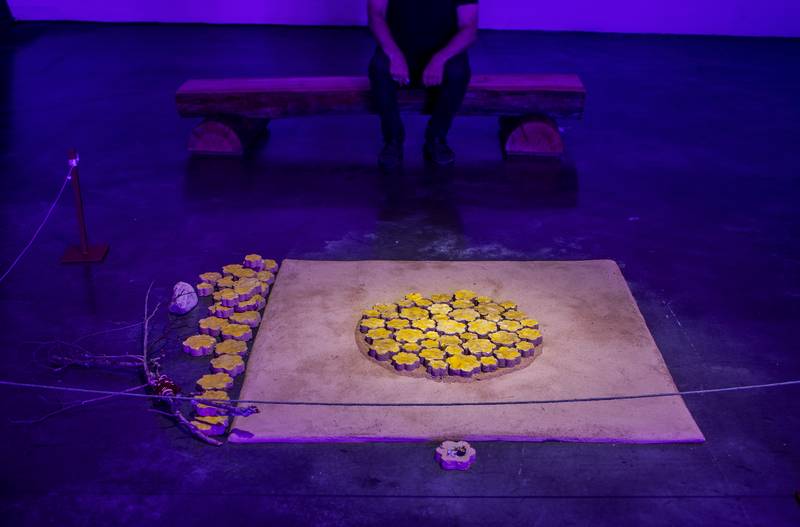

(ka) pheko ye - the dream to come, Dineo Seshee Raisibe Bopape, Kiasma 2023, Image: courtesy of Finnish National Gallery, Petri Virtanen
I remember this meeting so well; you also spoke about boundaries. You were in the midst of installing your new work. To me, your work has a lot of integrity. It’s an offering that invites you into this space of prayer. It prepares you for the dream. I think in this way, dreaming is really radical. I wanted to share a poem by Diane di Prima, Revolutionary Letter #75. It’s a rant about imagining and the importance of poetics. The following lines are repeated throughout the poem.
THE ONLY WAR THAT MATTERS IS THE WAR AGAINST
THE IMAGINATION
The word imagine makes me think of how we lack how to imagine the conditions that could support a different kind of working. Trying to imagine another way where we are not all so exhausted mentally and emotionally. How do we imagine working with joy or feeling nourished instead of becoming prisoners of the have to do it like this or must perform in this form? How to imagine? How to get out of the war with ourselves—the war that we agreed to partake in somehow because we are in this war together.
Isn’t it that the work makes you? So then it’s a kind of different way of thinking, and then there’s an act of recognition and transformation involved too. I feel that your work has the capacity to slow us down, not in a contemplative or meditative way, but in a deeply political sense of not just relying on sight and seeing or making sense. You make spaces where we are able to recharge, resist, and dream. What are your tools and your medicine to stay sane?
Many things, including the walking. Walking in South Africa is very different from walking in other parts of the world because of the social politics here, which always means that I have to be conscious of what else is happening around me. I cannot devout that from where I am. Sometimes it feels unnourishing, and other times it also offers some kind of abrasive thing that is another part of reality. Perhaps both are nourishing. It’s funny that I am saying that because I don’t enjoy it when it’s happening, like having the need to then have the difficult conversation with the curators today. I can recognise that having the conversation might be good for me (nourishing) in the long run, but during the event – it is an inner turmoil. What are some of yours?
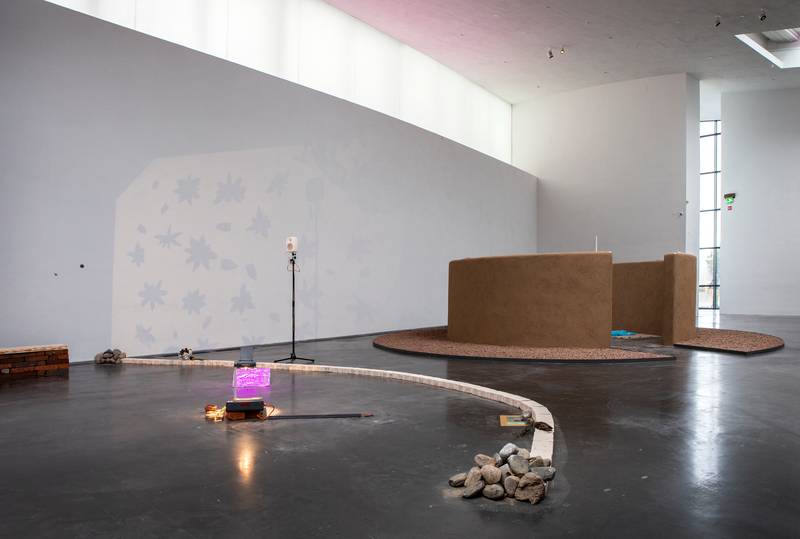

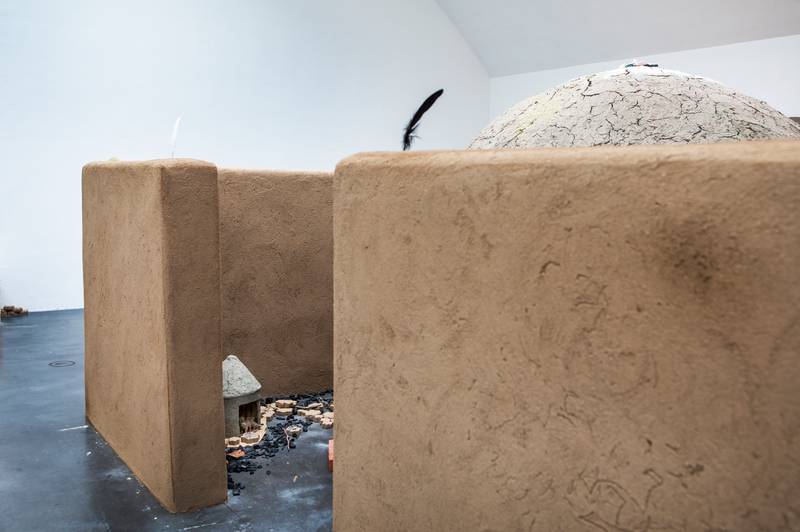

(ka) pheko ye - the dream to come, Dineo Seshee Raisibe Bopape, Kiasma 2023, Image: courtesy of Finnish National Gallery, Petri Virtanen
Walking is also one of mine. I walk for hours every day, usually in the forest. Walking makes me feel like I belong. With every step, I make a commitment to the place. I also do that because I have a hard time concentrating. It’s my daily practice. I also write, chant and dream, of course… You know the word dream etymologically comes from the words song and joy.
Like the song lines: “The dreams of the elders, the dreams of the land." I love walking barefoot on soil. The ground here has a lot of thorns, but it’s so nice to have my feet carefully on it and mindfully stepping on the land. Connecting with plants in a conscious way. Sometimes I listen to them to see what’s there and remember that I am not alone and that there are generations that came before. When you were speaking about walking the earth and your commitment to your presence and your journey, it reminded me of this song by Beautiful Chorus. Their music is like a cradle, a gentle carrying.
I wanna be here, I wanna shift, I wanna to grow, I wanna flow, I wanna to live…
Your work with dreams is so layered.
Dreams—there’s so much to them. The different levels of dream; the earth dream, the cosmic dream, the dream of making worlds, the dream of being with oneself and reconnecting with all parts of oneself, whether it be air or plants, the dream of time collapsing, the very last and first dream, and the in-between. The dream is medicine. Somebody yesterday was reflecting on how they had misbehaved in a dream, and so I was thinking about it a lot. I made a mental note, taking responsibility for how one behaves in a dream, that even in dream states, one has to be responsible. Something I have not quite figured out yet.
It makes me think of the Terrible Angel in the Duino Elegies. Like how we think of these ‘sacred places’ of dreams and angels. Maybe the dream is also something corporeal, something that is not so dreamy. What happens when sight does not control the experience? What do we see when we don’t see?
That takes me to the work of yours on the island, the prayers, the meditation and the smells Dreaming in this reality is so present. Being awoken sensuously, being brought back into the world by the rhythms and words that grow with the wind. Being contained.
I saw your new work at Kiasma both during the day and at dusk. During the day, we are exposed to the structures of the installation. At night, it expands, the sounds and shadows come through, they are alive, they have agency. We start to ‘see’ more, as if invited into the dream and dreaming. I also really enjoy that you are not spelling out your work. We have to experience it like sensuous knowledge.
It has to remain a mystery for me in the process of making it. This can sometimes be frustrating for the institution because not everything is listed as things that we need or this or that will happen; some things are left for wonder. There’s a saying that I copied from Spike Lee that goes something like, Make things that blow your mind. That’s the first thing I should be excited about - this thing or this experience and its relationship in-between the herbs or the materials and the conditions present. My mind must be blown by it, learning something from it and being transmuted by the process.
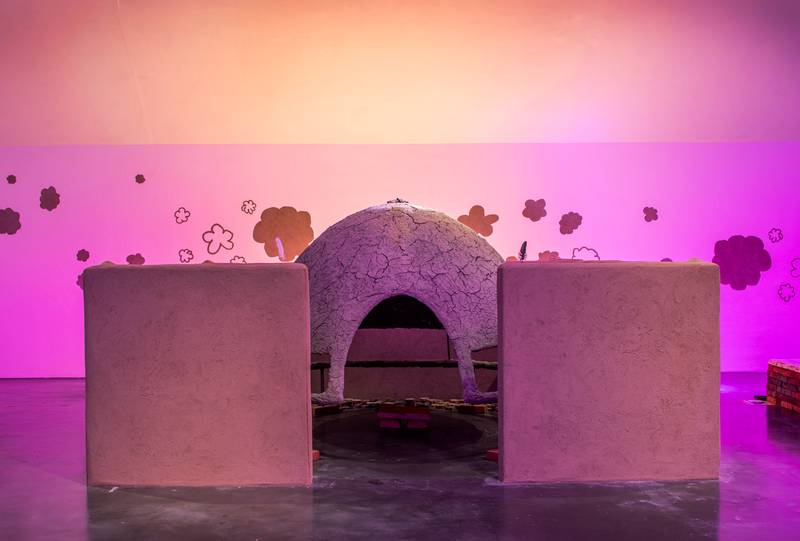

(ka) pheko ye - the dream to come, Dineo Seshee Raisibe Bopape, Kiasma 2023, Image: courtesy of Finnish National Gallery, Petri Virtanen
The work becomes a witness. It shapes you; it holds you. It’s your guide.
It makes me think of something related to Che Guevara and the people who fought beside him. That there was a need to constantly remember what the fight was for and also to remember the why? That why should always be the love of the people or the love of humanity in general. That’s the reason for then continuing to fight for justice, as one is being transmuted by the horrors of whatever state the traitors are in. The violence of transformation. It feels like a bit of a contradiction, but it’s the eruption that then happens that shifts us.
How not to forget? I want to quote something from Gayl Jones on how we carry our mothers and grandmothers’ stories in order to remember what we didn’t live through:
They are our counter histories, and we were supposed to pass it down like that from generation to generation, so we’d never forget, even though they burnt everything to play like it didn’t ever happen.2
It’s important that we carry all that heaviness. So that we remember.
I don’t know about that. I don’t know if it’s necessary, if it’s natural, or if it’s just the way things are?
It’s what moves us; it keeps us awake
Or a bit of both. Either too awake or too asleep. I was listening to A Working Class Hero by John Lennon, and somehow it was related to the conversation as well. There’s a part where he talks about the fear that is bred into a person like also a generational trauma. Fear as a certain kind of performance. I have been looking at different versions and different recordings of it, the different parts that are resonating from different beings, and also how credible it is in the now.
So in a way, we go back to how we started the conversation. I wanted to read a small part of June Jordan’s poem, Take Back the Night. It keeps repeating the line what about moonlight and reclaiming the night as a witness. The night and the moon are there, no matter what.
what about moonlight
what about moonlight
What about watching for the moon
so far from where you tremble
The poem is recalling humanity and also claiming back the owner, the voice of the poem. Also, what about the dream?
Maybe the dream is the medicine, and how we connect through the dream.
All of a sudden, it makes ‘sense’. The dream is a way of transmuting—how to be in the same world.


